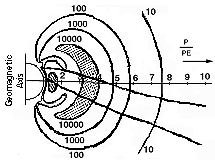(Files in red–history)
 Index Index
 10. Trapped Motion
10. Trapped Motion
 10H. Einstein, 1910
10H. Einstein, 1910
 10a. Particle Drift
10a. Particle Drift
 11. Explorers 1/3
11. Explorers 1/3
 11a. Geiger Counter
11a. Geiger Counter
 12. Rad. Belts
12. Rad. Belts
 12H. Argus 1958
12H. Argus 1958
 12a. Inner Belt
12a. Inner Belt
 12. Outer Belt
12. Outer Belt
 13. Fast Particles
13. Fast Particles
 14. Synch. Orbit
14. Synch. Orbit
 15. Energy
15. Energy
 16. The Sun
16. The Sun
 16H. Schwabe, 1843
16H. Schwabe, 1843
|
The space probes Pioneer 3 and 4 detected a wide belt of trapped particles beyond the inner belt. The intensity contours drawn here (together with the trajectories of the probes through space) were derived from their observations and are banana-shaped, because they follow magnetic field lines to which the particles are attached. We now know that outer-belt ions and electrons probably come from the long "magnetic tail" of stretched field lines on the night side of the magnetosphere.
 |
| The Two Radiation Belts
|
Now and then a violent outburst, known as a magnetic storm, drives tail plasma earthward, into the near-Earth magnetosphere. Electric fields (voltage differences) are essential to this process, to help tail particles break into trapped orbits and to drive them to higher energies. When the outburst ends and the electric field dies away, the particles find themselves locked in trapped orbits of the ring current and the outer radiation belt. Lesser outbursts, known as magnetospheric substorms, occur quite frequently.
Whereas the inner belt is marked by great stability, the ring current and outer belt constantly change. Sooner or later the particles are lost, e.g. by collision with the rarefied gas of the outermost atmosphere, and on the other hand, new ones are frequently injected from the tail. The electric fields which inject the new particles can also draw oxygen ions upwards from the ionosphere, and the ring current contains such ions, typically a few percent of the total, more during magnetic storms.
|
